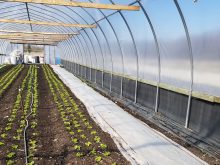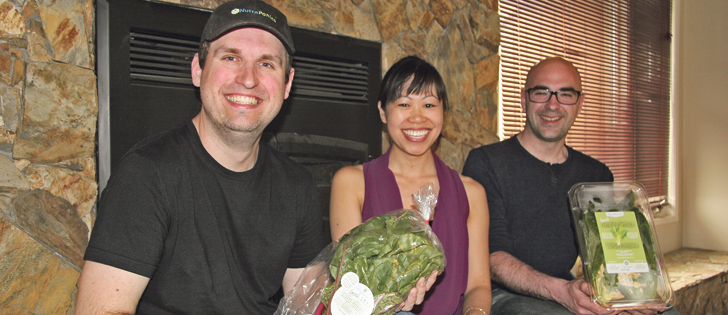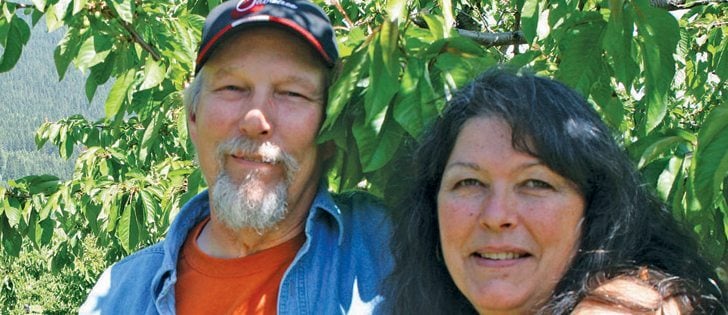DOG POUND, Alta. — The first things visitors see when they approach Solstice Berry Farm are long parallel rows of saskatoon bushes climbing up a hill toward Rick and Marsha Gelowitz’s home.
The family’s quarter section of hayland between Crossfield and Dog Pound was converted to a saskatoon orchard in 2003.
“We had done our homework, but until you start experiencing it, it is a lot more work than we thought, but the returns are starting to come now,” said Marsha.
The Gelowitzs planted 40,000 bushes on 40 acres over five years and used shelter belts to divide the orchard into numbered blocks.
Read Also

Farming Smarter receives financial boost from Alberta government for potato research
Farming Smarter near Lethbridge got a boost to its research equipment, thanks to the Alberta government’s increase in funding for research associations.
They opened for business seven years ago and have expanded each year. The trees are producing more fruit and the Gelowitzs have learned better production methods such as efficient fertilizer and fungicide application. They mulch their 29 kilometres of bushes each year to conserve moisture because they do not irrigate.
They also rely on others for information, which includes taking classes at Olds College and obtaining a Growing Forward grant so that Marsha could visit Alberta Agriculture’s food processing centre at Leduc.
Centre staff taught her how to handle large quantities of fruit and produce processed items such as pies, jams, jelly, juice and vinaigrettes, which they sell at their on-farm store, farmers markets and other distributors.
“It is a tremendous way to get the science behind what you are trying to do,” she told visitors to the farm in early August.
“There is help out there and you want to take advantage of that.”
They built a small licensed and inspected commercial kitchen in their home and obtained a mobile vendor licence.
Marsha has made 680 pies in four days and buys enough pectin to make 8,500 jars of jam and jelly. The Gelowitzs produce 200 dozen value-added saskatoon products.
They open the farm for U-pick for three weeks each summer and allow customers to browse through rows.
The Gelowitzs work hard during summer to capture as much value as they can from the perishable product.
“Harvesting when you have a bumper crop is a bit of a panic, struggling to get all that fruit off the trees and getting it into a form that is marketable,” Marsha said.
An 800 foot row yielded 2,255 pounds in one picking this year. It will be repicked because sask-atoons do not ripen evenly.
The farm uses a specialized berry harvester that gently shakes one side of the bushes and then delivers the berries into tote boxes at the back of the machine.
“I know we are going to leave a ton of fruit on the trees,” Rick said.
They don’t have the infrastructure to handle this year’s crop, which is five times the normal amount. They hire 14 seasonal workers, and many return each year.
Rick commutes to a job in downtown Calgary in the oil and gas industry, so they have come to depend upon reliable staff.
During their first year in production, Marsha, Rick and his parents picked over berries on a banquet table in a garage. It took them eight hours to sort 800 lb. of fruit.
Now they run the harvest on an assembly line.
Berries come off the tote boxes from the harvester and are upended onto an upward conveyor belt to remove stems, leaves, insects and dirt.
Berries come from the destemmer and move into lanes. An air jet is located under each lane, and a computer scans quality such as colour and weight.
An air jet blows unsuitable berries to the reject line.
The berries then come down an inspector conveyor belt, where workers look for flaws that the machine missed.
“It alleviates 95 percent of the work our staff had to do,” Rick said.
“This machine is capable of doing 5,000 lb. an hour.”
They have also installed walk-in coolers and added refrigeration trucks to deliver fresh fruit to farmers markets, processors or their own ventures. The fruit is also sometimes frozen.
“With the large crop we have this year, it has certainly exposed some shortcomings we have in our whole process, so we really have to think about how we can optimize this without spending $1 million,” Rick said.
He would like a larger building, better packaging line and loading docks.
Both see opportunity in saskatoon berries, which are high in antioxidants, fibre and potassium.
“I liken the saskatoon industry being where the blueberry industry was 30 years ago. People haven’t really discovered the saskatoon. Outside of Western Canada, they have never heard of saskatoons,” he said.
“It is a great story to tell, but not a lot of people know about it yet.”
Growing saskatoons
- Saskatoon berry bushes are adapted to a range of soil types but must have adequate drainage. A sandy loam is ideal, but they will manage on sandy soil and medium loam soil. Heavy clay loams and heavy clay should be avoided.
- Bushes do not tolerate saline soil or areas that retain water.
- Shelter belts are important during the saskatoon orchard’s establishment period.
- A general recommendation is to plant fruit crops on slight northeast or east facing slopes to allow the soil to warm more slowly in spring. It also delays blooming, which can protect blooms from late spring frosts.
- Prairie Plant Systems, a Saskatoon-based plant biotech company, recommends saskatoon berries be planted in spring after the risk of frost has passed in May or June, or in the autumn, but no later than Sept. 30.
- Plant spacing depends on the requirements of mechanical harvesters, but the recommended spacing is about 6.2 metres between rows and at least one metre within rows. Orchards for U-pick markets can place plants 3.5 metres apart between rows and two metres between plants within rows.
- Saskatoon varieties include Honeywood, JB30, Martin, Thiessen, Smoky.
Source: Prairie Plant Systems, Saskatchewan Agriculture
Contact barbara.duckworth@producer.com


















